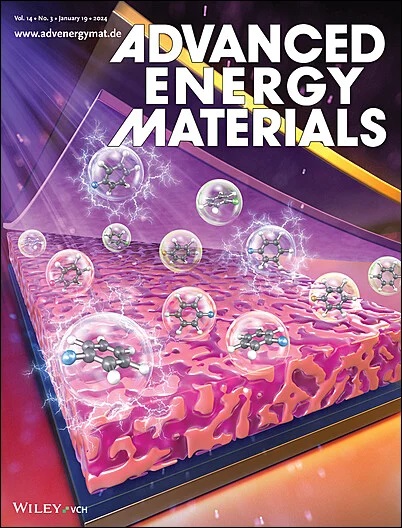Advanced N-Type Ionic Thermoelectric Cells Featuring Bidirectional Cationic Anchoring Strategy and REDOX Electrode
IF 24.4
1区 材料科学
Q1 CHEMISTRY, PHYSICAL
引用次数: 0
Abstract
The design of high-performance n-type ionic thermoelectric cells (i-TE cells) tailored for harvesting low-grade thermal energy presents significant challenges. In this study, an n-type i-TE cell exhibiting substantial negative thermopower and a high output energy density is developed by leveraging the synergistic interplay between thermal diffusion within an ionic hydrogel electrolyte and redox reactions at the electrode interface. Specifically, a gel network featuring dual positive groups is synthesized by cross-linking quaternized chitosan and guanidine molecules via glutaraldehyde, with thermal diffusion further enhanced by incorporating crown ether for complexation. Additionally, NiCo(CO3)(OH)2, a material known for its high hydrophilicity, is utilized as the anode to facilitate rapid ion and electron transfer at the electrode interface. The integration of optimized thermal diffusion within polycationic electrolytes with electrode interface-enhanced ion/electron transport mechanisms significantly improves the sustained output performance and thermoelectric conversion efficiency of the i-TE cell. Notably, the thermopower (Seebeck coefficient) of this n-type i-TE cell achieves a value of −26.04 mV K−1, and its 2 h output energy density reached 1301.61 J m−2 under a temperature difference (ΔT) of 15 K. These findings offer a novel design paradigm for high-performance n-type i-TE cell.

求助全文
约1分钟内获得全文
求助全文
来源期刊

Advanced Energy Materials
CHEMISTRY, PHYSICAL-ENERGY & FUELS
CiteScore
41.90
自引率
4.00%
发文量
889
审稿时长
1.4 months
期刊介绍:
Established in 2011, Advanced Energy Materials is an international, interdisciplinary, English-language journal that focuses on materials used in energy harvesting, conversion, and storage. It is regarded as a top-quality journal alongside Advanced Materials, Advanced Functional Materials, and Small.
With a 2022 Impact Factor of 27.8, Advanced Energy Materials is considered a prime source for the best energy-related research. The journal covers a wide range of topics in energy-related research, including organic and inorganic photovoltaics, batteries and supercapacitors, fuel cells, hydrogen generation and storage, thermoelectrics, water splitting and photocatalysis, solar fuels and thermosolar power, magnetocalorics, and piezoelectronics.
The readership of Advanced Energy Materials includes materials scientists, chemists, physicists, and engineers in both academia and industry. The journal is indexed in various databases and collections, such as Advanced Technologies & Aerospace Database, FIZ Karlsruhe, INSPEC (IET), Science Citation Index Expanded, Technology Collection, and Web of Science, among others.
 求助内容:
求助内容: 应助结果提醒方式:
应助结果提醒方式:


